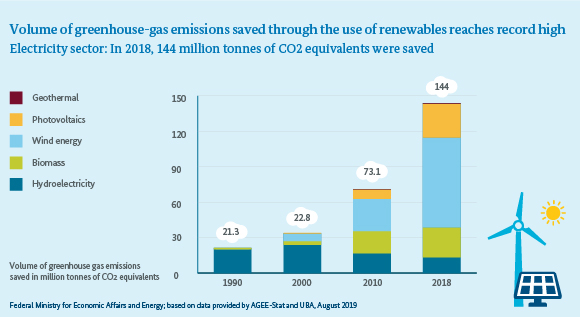In the electricity sector: Renewables use leading to big cuts in greenhouse-gas emissions
Using renewable energy plays a key role in reducing greenhouse-gas emissions. In 2018, renewables use enabled greenhouse gas emissions to be cut by twice as much compared to 2010.
 © Federal Ministry for Economic Affairs and Energy; based on data provided by AGEE-Stat and UBA, August 2019
© Federal Ministry for Economic Affairs and Energy; based on data provided by AGEE-Stat and UBA, August 2019
The use of fossil energy carriers is increasingly giving way to renewable energy sources. This means that the level of greenhouse gas emissions from combusting coal, gas and oil is falling. In 2018, the working group AGEE-Stat (responsible for generating statistics on the use of renewables) and the Federal Environment Agency (UBA) calculated that emissions with a total greenhouse gas potential of more than 187 million tonnes of CO2 equivalents were saved from being released in the electricity, heating, cooling and transport sectors. CO2 equivalents are a measure used to compare the emissions of different greenhouse gases based upon their global warming potential.
Greatest share of emissions saved in electricity sector, followed by heat and transport
The electricity sector accounted for the largest share of greenhouse gas emissions saved from release in 2018 – with a total of around 144 million tonnes of CO2 equivalents being cut. This corresponds approximately to the CO2 equivalents emitted by industry in 1996. (In 2018, Germany’s industrial sector emitted 131.7 million tonnes). In the heating sector, around 35.5 million tonnes of CO2 equivalents fewer were released into the atmosphere in 2018. For the transport sector, statisticians recorded a cut of around 7.7 million tonnes.
Savings in the electricity sector have doubled in eight years
Since 1990, the total volume of greenhouse gas emissions saved has also risen more or less steadily. Whereas in 1990 renewables use accounted for a cut of only 21.3 million tonnes of CO2 equivalents, survey results for the year 2000 already showed savings of 33.8 million tonnes. In 2010, savings of CO2 equivalents in the electricity sector amounted then to 71.1 million tonnes and, by 2018, had more than doubled.
Power generation from wind energy cuts greatest volume of greenhouse gas emissions
In 2018, the greatest share of greenhouse gas emissions was saved by electricity generation from wind turbines (76.3 million tonnes of CO2 equivalents, of which almost 62.7 million tonnes fell to onshore and 13.6 million tonnes to offshore), followed by photovoltaics (28.7 million tonnes), biomass (25.6 million tonnes), hydropower (13.2 million tonnes) and geothermal energy (0.093 million tonnes). By comparison, in 2010, emissions savings accruing to wind turbines still sat at 27.5 million tonnes, compared with only 6.4 million tonnes in 2000 and around 3.2 million tonnes in 1999.
In the electricity sector, the result of the calculations is significantly influenced by which fossil or nuclear fuels are replaced by renewable energy. For a detailed explanation of the basic methodology used to calculate the emission balances for renewable energy sources, please see the UBA publication Emissionsbilanz erneuerbarer Energieträger (available in German only).

